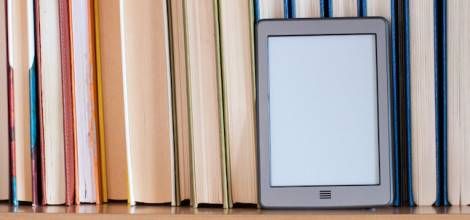
Why Romance Readers Love Digital Books
If you listened to the 7-25-2016 Book Riot Podcast, you heard Jeff and Rebecca talking about a presentation at the Romance Writers of America annual conference. It was on romance readers’ book buying habits, called Romancing the Data, by AuthorEarnings.com.
One of the stats that really stands out is the way romance readers have embraced ebooks:
“Romancing the Data” by AuthorEarnings.com
And also the huge percentage of romance readers who buy ebooks:
“Romancing the Data” by Authorearnings.com
I thought I’d take a stab at explaining why romance readers tend to read more in digital than readers of other genres. I’m no expert, but I’m an avid romance reader. I’m also a semi-early adopter of digital reading (I bought the second gen Kindle in 2009). And I’m a regular participant in romance discussions on the internet. So, here are my thoughts:
- History. Romance readers were primed to be early adopters of both digital books and ereaders. Amazon’s first Kindle launched in 2007 at a whopping $399. Who was going to buy that thing? Well, people who read a LOT, and could save money and space by buying digital. Harlequin was publishing digital versions of its books as early as 2006. As romance readers bought more ebooks, they created a larger market for new (or fairly new) small, independent romance publishers, like Ellora’s Cave, Loose ID, Freya’s Bower, Cleis Press, Bold Strokes Books, Siren Publishing, Changeling Press, Samhain Publishing, and others. These presses catered to specific niches that either didn’t exist or were underrepresented by mainstream romance presses, whether that meant erotic, paranormal, SFF, GLBTQ, or African-American romance. In short, romance started out as an industry leader in digital and has retained that lead.
- Disposable income and tech savvy. According to RWA statistics, the average romance reader is aged 30-55, earns $55000 a year, is college educated and has a partner. All of these things point to having a little more money and probably some new tech.
- Finding the stories readers are looking for. Following that first wave of independent ebook publishers, other digital first romance publishers have entered the market: Entangled, Riptide Publishing, and Crimson Romance, to name a few. Although there is overlap with romance offerings from the Big Five, these smaller houses still offer storylines, styles, and characters hard to find elsewhere.
- A lot of popular, traditionally published authors now self-publish in digital format instead of, or in addition to, traditional publishing. Courtney Milan, Bella Andre, Laura Florand, Marie Force, Carly Phillips, Nalini Singh, Jennifer Ashley, Joan Wolf, Kit Rocha, Jessica Scott, Lara Adrian, and Thea Harrison, to name a few of the better known. Romance readers are very used to following favorite authors across platforms and publishing styles.
- Backlists. Romance readers will glom the backlist of a new favorite author. This is encouraged by the genre itself which tends to be written in series. Many beloved writers have published their backlists in digital format only. And first books in a series are often heavily discounted.
- Although self-published books can be very mainstream, some writers turn to self-publishing for books that can’t find a home with a publisher. Are loads of these utter crap? Yep. But some are unusual or niche stories editors don’t think will sell.
- Independently-published digital books are often cheap (free or 99 cents).
- Most romance readers buy their digital books through Amazon.com, where it’s hard to tell whether a book is indie published or published by a traditional publisher. With a more level playing field, self-published digital books have a much better chance at being discovered.
- To keep prices down, among other motives, the subscription service Kindle Unlimited offers lots of romance that skews almost completely towards indie authors.
I can think of a few other possibilities, but they may be more of a stretch. For example, if romance readers tend to be avid readers, and if 59% of them are coupled up, maybe being able to read at night without keeping your partner awake. Or, maybe it’s true that women are better multitaskers than men (or at least believe the hype), and since 84% of romance readers are women, the appeal of being able to access a book while doing other things is extra strong.
Ok, the armchair from which I’m wildly speculating is about to burst into flames. What percentage, if any, of your reading is done digitally?










